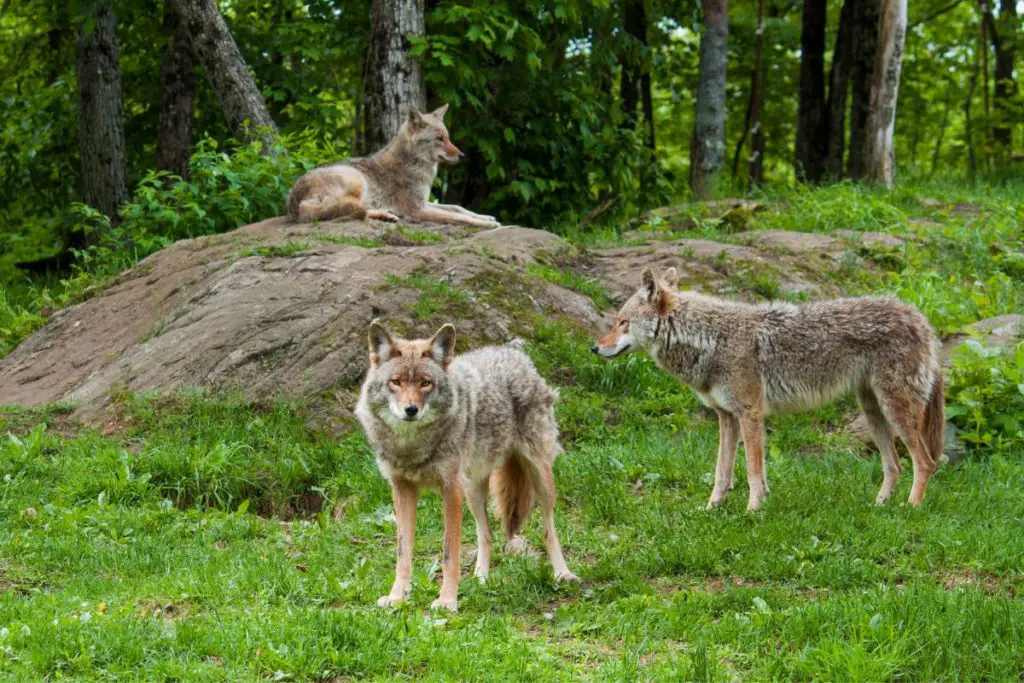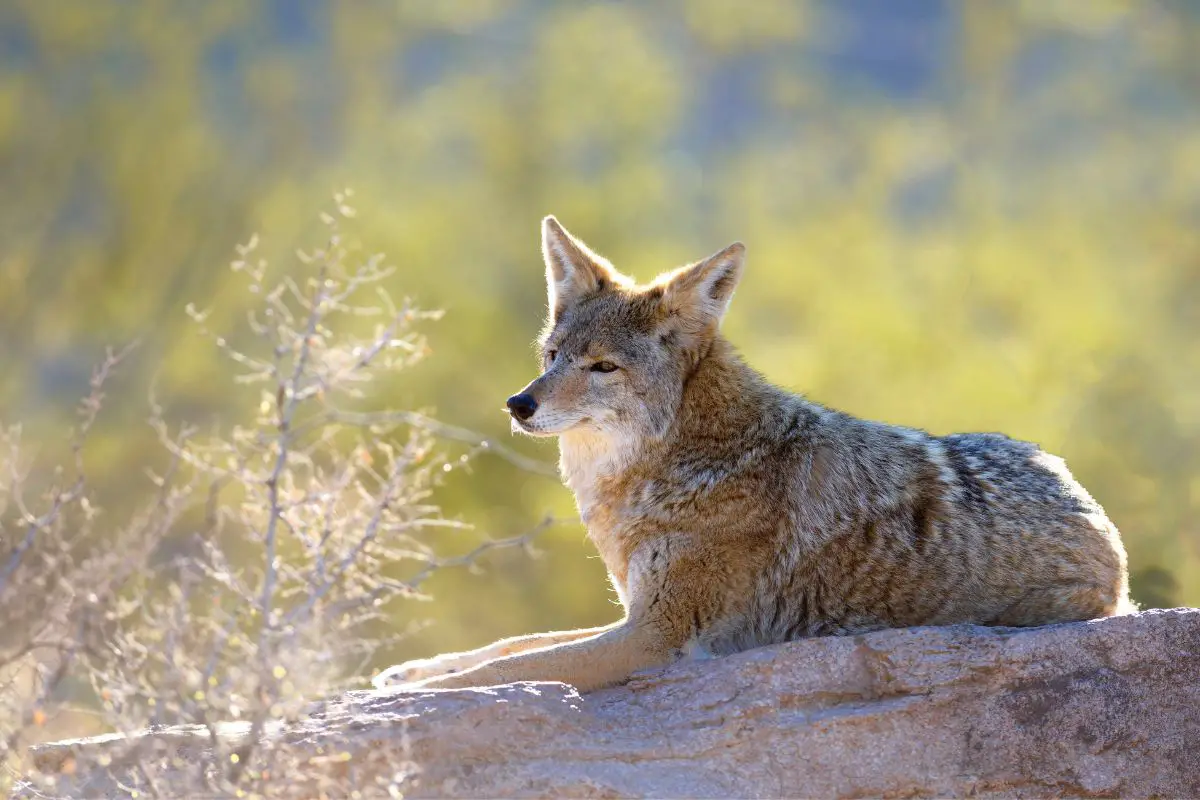Highly intelligent and adaptable, the coyote has survived persecution that drove away the wolf, mountain lion, black bear, and other predators once found in much of the contiguous United States.
The species maintains its numbers despite increasing human encroachment and efforts to eliminate them. Let’s take a look at the coyote’s average lifespan in the wild, as well as in captivity.
How Long Do Coyotes Live?
In the wild coyotes live around 6 to 8 years. Coyotes that live in captivity may live as long as 18 years with the proper care and medical treatment. The maximum known age for a coyote in the wild is 14.5 years.
There are nineteen subspecies of coyotes spread out over North and Central America. Their lifespans will vary depending on the area where they live, the food and water sources, and other factors.
Those near urban areas have an increased threat of being killed by motor vehicles while those in rural areas have an increased threat of being hunted, trapped, or shot.
How Long Do Coyotes Live In the Wild
Adult coyotes are very rarely killed by other wild species. Pups are more susceptible to predation. Predators include cougars, bears, eagles, dogs, other coyotes, and humans.
Many other factors can affect coyote longevity other than natural predation. Malnutrition and disease are common mortality factors. Coyotes are vulnerable to a variety of diseases, including parvoviral enteritis, mange, canine distemper, and rabies.
Urban coyotes typically live less than two years, with vehicle collisions being the most common cause of death. In rural areas, the biggest threat to coyotes is being hunted and trapped.
How Long do Coyotes Live in Captivity?
Coyotes can be difficult to observe in the wild because they are mostly nocturnal and/or live in heavily forested regions making them difficult to see.
In some locations seasonal observations of coyotes are possible, but in most landscapes, observers must rely on radio-telemetry (radio signals to detect movements) to remotely detect coyote activity using a transmitter.
Coyotes kept in captivity can provide important information that cannot be collected in the wild. Coyotes have lived up to 20 years of age in captivity, with access to a healthy food source, clean water, and veterinarian care. As well as protection from predators.
In captivity, under the right conditions, coyotes can live long meaningful lives. Allowing us to gather data from them, while also making sure they are well cared for.
Survival Rates and Age
Coyotes have similar lifespans as other canines, but unlike our cherished pets they have to deal with nature daily. Therefore, their typical longevity is only about 1 ½ years. With many dying in their first year of life and few surviving beyond three years. Estimates of annual survival among adult coyotes range from 40% to 80%.
The term “pup” refers to coyotes that are less than 1 year old, “yearling” refers to coyotes that are 1 to 2 years old, and “adult” refers to coyotes that are older than 2 years of age. Pup mortality is high, with an average of 50-70% dying within their first year.
One study found 70% of individuals in spring (pre-whelping) to be less than 3 years old and less than 5% to be more than 9 years old. The same study reported a 40% annual mortality rate for coyotes more than a year of age, with relatively high survival rates between years 4 and 8.
| Age | % of Population |
| 1 | 41.1 |
| 2 | 19.1 |
| 3 | 11.0 |
| 4 | 6.6 |
| 5 | 6.6 |
| 6 | n/a |
| 7 | 3.7 |
| 8 | 2.7 |
| 9 | 2.1 |
| 10 | 1.3 |
| 11 | .3 |
| 12 | .9 |
The table depicts coyote mortality rates in populations. Mean percentage values are based on seven studies.

Coyote Management
The coyote is one of the most successful predators in the United States. Because of their high numbers, there has been a government effort to help manage their populations.
The United States Department of Agriculture’s Wildlife Services is responsible for the deaths of over 62,000 of the estimated 500,000 coyotes that are killed each year. Coyotes are the major predator responsible for livestock losses on farms and ranches in the U.S.
Wildlife Services have been investing in research for many years to develop effective non-lethal methods to control damage to livestock by coyotes. Although they have had some success, many non-lethal measures such as repellents and scare devices have not worked because the coyote has adapted to them. Source.
Depredation Management Methods (lethal)
Aerial shootings have been one of the most successful ways to manage the coyote population and quell livestock predation. According to Wildlife Services officials, the program is conducted in areas in which predation routinely occurs and is timed to remove coyotes, before, or during their mating season.
The intent is to reduce the number of coyotes that have pups to feed just as the lambing season begins. The officials point out that aerial shooting activities are both effective and cost-efficient in preventing livestock losses, according to a 3-year study by Utah State University researchers.
Lethal techniques include shooting, aerial shooting, predator calling, and night shooting.
Toxicants are another lethal management tool. Some common toxicants used to reduce coyote populations are Sodium cyanide, Sodium fluoroacetate, (used in the livestock protection collar,) and large gas cartridges containing 53% sodium nitrate, 28% charcoal, and 19% inert ingredients to produce primarily carbon monoxide, along with other lethal gasses. Trained dogs often assist in coyote management. Source.
Depredation Management Methods (non-lethal)
Removal of coyotes by lethal means, while necessary in some circumstances, is not effective for overall population control. Despite guns, dogs, poisons, and traps, the coyote has managed not only to survive but to extend his range into new territory.
Hundreds of thousands of coyotes are killed each year, yet a large and healthy population remains.
Non Lethal management techniques include; animal husbandry, use of herders or shepherds, net-wire fencing, electric fencing, corrals, scare devices, bells and radios, fladry, Propane cannons, strobe lights, and sirens, guarding animals such as dogs, donkeys, llamas, as well as habitat modification, hazing, Repellents, and relocation.
See our article for How Smart Are Coyotes?
In Conclusion
Wiley and elusive, intelligent, adaptable, and resilient the coyote succeeds against insurmountable odds. Lethal approaches to population control of the species have been ineffective, disrupting the group hierarchy while allowing for larger litter sizes and allowing more coyotes to reproduce.
When one or both of the dominant pair are killed other pairs form. Transient coyotes and younger coyotes can form multiple mating pairs. Unlike the wolf, the coyote remains a dominant predator of the Americas, who will not be killed off or driven away.
- Hero Farm Dog Survives Epic Battle with Coyote Pack - December 9, 2024
- The 10-Minute Bedtime Routine That Changed My Dog’s Sleep Forever - November 29, 2024
- Creating a Safe Space for Nervous Pets: Your Guide to Pet-Friendly Havens - November 25, 2024

